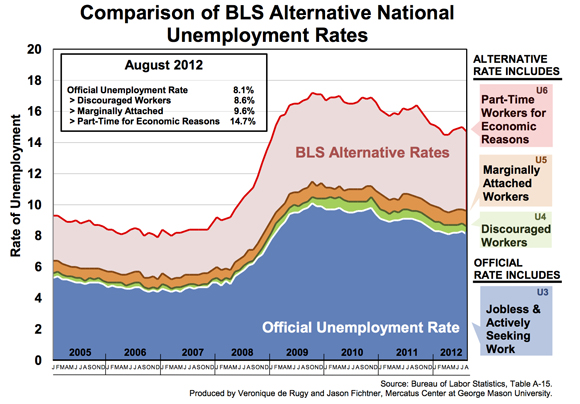In this week’s chart, Mercatus Center senior research fellows Veronique de Rugy and Jason Fichtner provide a comparison of the official unemployment rate reported by the media with alternative measures of the unemployment rate reported by the Bureau of Labor Statistics (BLS). Data from the BLS is used to assess labor market conditions from several perspectives.

In this week’s chart, Mercatus Center senior research fellows Veronique de Rugy and Jason Fichtner provide a comparison of the official unemployment rate reported by the media with alternative measures of the unemployment rate reported by the Bureau of Labor Statistics (BLS). Data from the BLS is used to assess labor market conditions from several perspectives.
The most commonly reported unemployment rate—8.1 percent in August 2012—includes the number of people without jobs who are available to work and are actively seeking work in the four weeks preceding the survey as a percentage of the labor force (the sum of employed and unemployed persons in the economy). While this official unemployment rate remains the primary measure of labor market performance, there are reasons to believe that it is not the most realistic representation of the current state of the economy.
For instance, the BLS’ alternative measures depicted in the chart above provide three scenarios that build off this official definition of unemployment. As more factors are considered, the BLS’ unemployment rate grows in magnitude and, in effect, provides an increasingly more realistic depiction of the extent to which the economy is not fully utilizing its labor resources.
For example, in August 2012, 2.6 million persons were marginally attached to the labor force. These individuals were not in the labor force, but wanted and were available for work, and had looked for a job sometime in the previous 12 months. However, they were not counted as unemployed because they had not searched for work in the four weeks preceding the survey.
The base of the chart shows the official unemployment rate (U3: blue portion). When discouraged workers (persons not currently looking for work because they believe no jobs are available for them) are added to this base as a percentage of the civilian labor force, the unemployment increases slightly (U4: green portion). When all other marginally attached workers are further added to this number as a percentage of the civilian labor, the unemployment rate number climbs yet a little higher (U5: orange portion).
When the total number of people employed part-time for economic reasons (those working part time because their hours have been cut back or because they are unable to find a full-time job) are added to the total number of (i) unemployed persons, (ii) discouraged workers, and (iii) all marginally attached workers, as a percentage of the civilian labor force, the unemployment rate soars above the official unemployment rate (U6: red portion). This last scenario provides a more accurate measure of the real economic conditions in the labor market.
This alternative measure (U6) has remained above 10 percent since June 2008. Most recently, in August, the reported official unemployment rate was 8.1 percent. After including the impact of discouraged workers, marginally attached workers, and those working part time for economic reasons, the rate drastically increases to 14.7 percent—nearly twice the official unemployment rate.
Regardless of which measure of unemployment you use, the stark increase in unemployment since 2008 shows there hasn’t been any meaningful, sustained improvement in the labor market for more than two years.



